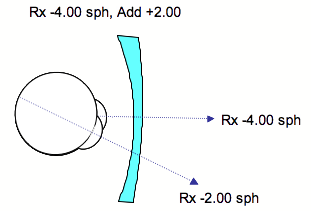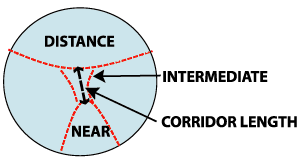Understanding progressives makes explaining their advantages easier. If you are presbyopic yourself and wear progressives, it’s really easy. If not – here’s what you need to know.
The front surface of a progressive lens steepens towards the bottom and that creates a gradual increase in plus power (Fig. 1).The result is a smooth, continuous increase of the add power, without visible lines or interruption of vision.

There are three distinct zones of vision. Distance, a stabilized zone located in the upper portion of the lens, provides the far vision prescription. The Near, is a the lower add portion of the lens, and the Intermediate, a central ‘corridor’ that connects distance and near increasing progressively in plus power (Fig. 2).These three zones of vision blend together seamlessly, providing the wearer with a continuous range of vision from distance to near.

Modern progressives have minimal blur, i.e. the astigmatism created has been reduced to about the mathematical limit or about equal to the add power. New free-form or digital surfacing techniques allow the astigmatic and power errors to be further reduced so there is little blur. Patients will comment that the lenses are clearer overall, with crisper, higher contrast images. This is accomplished by increasing the precision by which the molds are cut to make a semi-finished progressive and then further reducing the remaining errors by compensating for them on the back surface of the lens. The result is progressive lenses with eye comfort, smooth transitions throughout the lens, amazingly clear vision and the most natural-like vision.
The newest designs can be adjusted to the wearer’s prescription, frame choice, fitting measurements and visual habits. They include variable inset and corridor lengths, corridors have been shortened, and the designs are changed considering the prescription’s magnification and minification effects.













